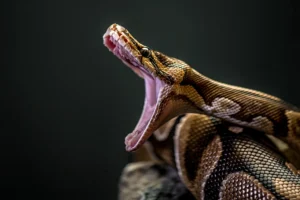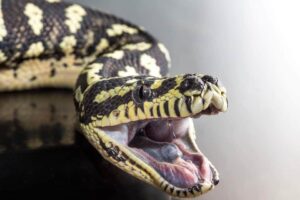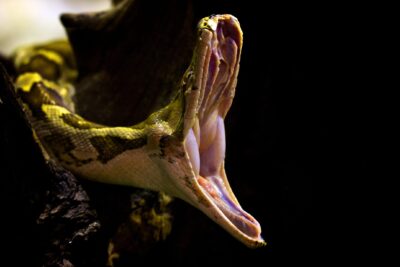Are ball pythons poisonous? This question often arises among those considering these captivating reptiles as pets or encountering them in the wild. Ball pythons, scientifically known as Python regius, are popular among reptile enthusiasts for their docile nature and striking appearance.
Ball pythons are not poisonous. They are constrictors, meaning they kill their prey by wrapping around them and squeezing until they suffocate, rather than relying on venom.
In fact, ball pythons are known for their docile nature and are popular pets among reptile enthusiasts. While they may look intimidating, their lack of venom makes them safe to handle for most people.
Are ball pythons poisonous?

Ball pythons are not poisonous. They are constrictors, which means they kill their prey by wrapping around them and squeezing until they suffocate. Unlike venomous snakes, such as cobras or rattlesnakes, ball pythons do not inject venom into their prey.
The confusion might arise from the term “poisonous” being mistakenly used interchangeably with “venomous.” “Poisonous” typically refers to something harmful if ingested or touched, while “venomous” refers to organisms that inject venom into their prey through specialized structures, like fangs. Since ball pythons lack venom glands and fangs for injecting venom, they are not venomous.
It’s always a good idea to clarify these distinctions, especially for those who might be new to learning about different types of snakes.
Misconceptions About Ball Pythons Being Poisonous
Misconceptions about ball pythons being poisonous often stem from a misunderstanding of snake terminology and characteristics. Here’s a breakdown of some common misconceptions:
- Confusion between Poisonous and Venomous: As mentioned earlier, people sometimes confuse the terms “poisonous” and “venomous.” While venomous snakes inject venom into their prey, poisonous animals produce toxins that can harm if ingested or touched. Ball pythons are neither poisonous nor venomous; they kill their prey by constriction.
- Appearance and Behavior: Ball pythons might be mistaken for venomous snakes due to their similar appearance to some species of pythons and boas that are venomous, such as the Gaboon viper. Additionally, their habit of coiling up when threatened might be misinterpreted as a defensive posture seen in some venomous snakes.
- Lack of Understanding: Many people might not be familiar with the characteristics and behaviors of ball pythons and other non-venomous snakes. This lack of understanding can lead to misconceptions and unwarranted fear.
To address these misconceptions, education and awareness about snake biology, behavior, and terminology are essential. Providing accurate information about ball pythons and other non-venomous snakes can help dispel myths and promote appreciation and respect for these fascinating reptiles.
The Importance of Proper Handling and Care
Proper handling and care are crucial for the health and well-being of ball pythons, as well as for the safety of both the snake and its keeper. Here are some key reasons why:
- Health Maintenance: Proper handling and care help maintain the physical and mental health of ball pythons. This includes providing suitable habitat conditions such as temperature, humidity, and substrate, as well as a balanced diet and access to clean water. Regular handling can also help identify any health issues early on, allowing for prompt veterinary care if needed.
- Reducing Stress: Ball pythons, like many reptiles, can experience stress if not handled properly. Stress can weaken the immune system, making the snake more susceptible to illness. Gentle and infrequent handling, along with providing adequate hiding spots in their enclosure, can help minimize stress and promote overall well-being.
- Behavioral Enrichment: Handling can provide important behavioral enrichment for ball pythons. While they are generally solitary animals, some level of interaction with their keeper can help prevent boredom and promote mental stimulation. However, it’s essential to respect the snake’s boundaries and not handle them excessively or inappropriately.
- Safety: Proper handling techniques are essential for the safety of both the snake and its keeper. Ball pythons have the potential to bite if they feel threatened or stressed, although they are typically docile and rarely aggressive. Knowing how to handle a snake safely can help prevent accidents and injuries.
- Education and Connection: Handling and caring for a ball python can provide valuable educational opportunities and foster a deeper connection between the keeper and the snake. Learning about the snake’s natural history, behavior, and care requirements can be a rewarding experience and help promote responsible pet ownership.
Risks associated with mishandling ball pythons
Mishandling ball pythons can pose various risks to both the snake and the handler. Here are some potential risks associated with mishandling:
- Stress and Agitation: Mishandling, such as rough or improper handling techniques, can cause stress and agitation in ball pythons. Stress can lead to a variety of health issues, including decreased appetite, compromised immune function, and increased susceptibility to illness.
- Bites: Ball pythons may bite if they feel threatened, cornered, or mishandled. While their bites are not usually venomous or dangerous to humans, they can still cause pain, swelling, and potential infection. Bites can also result in increased fear and stress for both the snake and the handler.
- Physical Injury: Rough handling or dropping a ball python can cause physical injury to the snake, such as bruising, internal injuries, or fractures. Additionally, mishandling can lead to the snake escaping or falling from a height, which can result in serious harm.
- Behavioral Issues: Consistent mishandling can contribute to the development of behavioral issues in ball pythons, such as increased aggression or defensive behaviors. This can make handling more challenging and may require specialized training or behavior modification techniques to address.
- Transmission of Diseases: Mishandling can potentially increase the risk of transmitting diseases or pathogens between ball pythons and humans. While the risk is relatively low with proper hygiene practices, mishandling can inadvertently expose both the snake and the handler to pathogens.
To minimize these risks, it’s essential to handle ball pythons gently, calmly, and with respect for their natural behaviors and boundaries. Handlers should always wash their hands before and after handling the snake, avoid sudden movements or loud noises that may startle the snake, and never attempt to force the snake into a situation where it feels threatened or uncomfortable.
Additionally, proper education and training on safe handling techniques are essential for anyone interacting with ball pythons.
Safety Concerns with Ball Pythons

Safety concerns with ball pythons primarily revolve around potential risks associated with handling, husbandry, and interactions between the snake and its environment. Here are some key safety considerations:
- Bites: While ball pythons are generally docile and rarely bite, there is still a risk of being bitten, especially if the snake feels threatened, stressed, or mishandled. Ball python bites are usually not dangerous but can cause pain, minor swelling, and potential infection if not properly cleaned and treated.
- Constriction: Although ball pythons are not large enough to constrict humans, there is a risk of the snake inadvertently constricting around sensitive areas such as the neck or limbs if it feels threatened or perceives the handler as prey. This is rare but can potentially occur if the snake is mishandled or agitated.
- Escape: Ball pythons are skilled escape artists and can squeeze through surprisingly small openings. Ensuring the enclosure is secure with tight-fitting lids and escape-proof locks is essential to prevent the snake from escaping and potentially getting injured or lost.
- Allergies and Zoonotic Diseases: Some individuals may have allergies to snake dander or saliva, which can cause allergic reactions upon contact. Additionally, there is a small risk of zoonotic diseases, such as salmonella, being transmitted from reptiles to humans through contact with feces or contaminated surfaces. Practicing good hygiene, such as washing hands thoroughly after handling the snake or cleaning the enclosure, can help minimize these risks.
- Handling Equipment: Using appropriate handling equipment, such as snake hooks or tongs, can help reduce the risk of accidental bites or injuries during handling. Handlers should avoid using their hands to restrain or manipulate the snake, especially if they are inexperienced or unsure of the snake’s behavior.
- Temperature and Humidity: Maintaining proper temperature and humidity levels in the snake’s enclosure is essential for its health and well-being. Improper temperature or humidity levels can lead to health issues such as respiratory infections or dehydration. Using reliable temperature and humidity gauges and providing appropriate heating and humidity sources can help mitigate these risks.
Overall, practicing safe handling techniques, providing proper husbandry, and being aware of potential risks can help ensure the safety of both the handler and the ball python. Additionally, seeking guidance from experienced reptile keepers or herpetologists can provide valuable insights and tips for safely caring for these fascinating animals.
Advice for addressing safety concerns for pet owners
For pet owners concerned about safety when handling ball pythons, here are some key pieces of advice:
- Education and Training: Educate yourself about ball python behavior, body language, and safe handling techniques. Attend reptile care workshops, read reputable books or online resources, and seek guidance from experienced reptile keepers or herpetologists. Understanding your snake’s needs and behaviors can help you handle them safely and confidently.
- Start Slowly: If you’re new to handling snakes, start with short handling sessions and gradually increase the duration as both you and the snake become more comfortable. Begin by gently touching and holding the snake for brief periods, gradually progressing to longer handling sessions as the snake acclimates to being handled.
- Respect Boundaries: Respect your snake’s boundaries and avoid handling them when they are feeding, shedding, or stressed. Learn to recognize signs of stress or discomfort, such as hissing, defensive postures, or rapid movements, and give the snake space when needed.
- Use Proper Handling Equipment: Use appropriate handling equipment, such as snake hooks or tongs, to safely handle your ball python. Avoid using your hands to restrain or manipulate the snake, especially if you’re unsure of its behavior or temperament.
- Supervise Interactions: Always supervise interactions between children and ball pythons to ensure both the child and the snake’s safety. Teach children how to handle the snake gently and respectfully, and never leave them unsupervised with the snake.
- Secure Enclosures: Ensure your ball python’s enclosure is secure and escape-proof to prevent the snake from escaping and potentially getting injured or lost. Use tight-fitting lids with secure locks, and regularly inspect the enclosure for any signs of wear or damage.
- Practice Good Hygiene: Wash your hands thoroughly with soap and water before and after handling your ball python or cleaning its enclosure. Keep the enclosure clean and sanitized to minimize the risk of spreading bacteria or disease.
- Seek Veterinary Care: If you notice any signs of illness or injury in your ball python, seek veterinary care from a reptile-experienced veterinarian promptly. Early intervention can help prevent health issues from worsening and ensure the well-being of your snake.
By following these guidelines and prioritizing safety and proper care, you can enjoy a rewarding and enriching relationship with your ball python while minimizing risks for both you and your pet.
Conclusion
This page answers the question on are ball pythons poisonous. As non-venomous constrictors, they rely on constriction to subdue their prey, rather than injecting venom.
While misconceptions about their classification persist, understanding the distinction between venomous and non-venomous snakes is crucial. Therefore, it’s important to clarify that ball pythons pose no threat of venomous poisoning.

